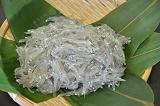Tagonoura Shirasu
| Registration Number | 36 |
|---|---|
| Name of the GI | Tagonoura Shirasu |
| Class | Fish and Shellfish |
| Date of Protection | 2017/06/23 |
| Producing Area |
Shizuoka Prefecture
Offshore of Tagonoura (Offshore of Fuji City and Numazu City),in Shizuoka Prefecture |
| Applicant - Name and Address | Tagonoura Marine Cooperative 866-6 Shinden, Maeda, Fuji City, Shizuoka Prefecture, 416-0937, Japan |
Tagonoura Shirasu are whitebait caught in the offshore of Tagonoura in Shizuoka Prefecture, and landed at Tagonoura Port in the prefecture. They have high freshness, transparency, and a chewy texture.
Raw whitebait easily loses its freshness and discolors, but due to its high freshness, as long as they are kept properly, Tagonoura Shirasu retain their transparency and chewy texture from when they are landed in the morning to the evening of the same day. Even if frozen and then defrosted, they still have the same chewy texture and are almost indistinguishable from when they were landed.
At the Tagonoura Fisherman's Cafeteria which began operations in 2011, raw whitebait rice bowl is the most popular dish. During the business period from April to December, more than 70,000 visitors come every year to eat raw whitebait rice bowls. Tagonoura Shirasu are highly valued as raw food, but are also popular as Kamaage (straight-from-the-pot). After boiled, they bend around the neck and plump up into the shape of the Japanese hiragana character "shi" in a delicious dish known as "Kamaage shirasu".
Behind the freshness which is the biggest feature of Tagonoura Shirasu, there is a standard freshness management process. After they are caught, they are immediately transferred to a sieve on the ship, and firmed up on a large amount of ice while draining off water. By using the sieve, excess water is removed to prevent the whitebait from becoming soggy. While they are firming up on ice, they are taken directly to port and immediately brought to market to maintain their freshness.
The fishing grounds of Tagonoura Shirasu are located in the northernmost part of Suruga Bay where nutrition from melting snow on Mt. Fuji and the Southern Alps pours abundantly into. As a result, plankton, the food of Tagonoura Shirasu, are well nurtured, and create perfect conditions for shirasu fishing grounds.
In the vicinity of Tagonoura, shirasu had long been caught by dragnet fishing from the beach. When the port was completed in 1961, it became possible to moor large ships, and fishing was then done by shirasu fishing vessels. Normally, a method of stringing a net between two boats is adopted as it can catch a lot of fish, but since the fishing grounds of Tagonoura is very steeply, they are not suitable for this method. Instead, fishing has always been done by a one-boat net. This fishing method is actually more effective, and allowed the shirasu to be landed without damaging them.


